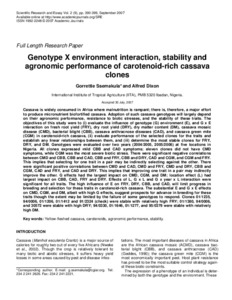| dc.description.abstract | Cassava is widely consumed in Africa where malnutrition is rampant; there is, therefore, a major effort to produce micronutrient biofortified cassava. Adoption of such cassava genotypes will largely depend on their agronomic performance, resistance to biotic stresses, and the stability of these traits. The objectives of this study were to (i) evaluate the influence of genotype (G) environment (E), and G x E interaction on fresh root yield (FRY), dry root yield (DRY), dry matter content (DM), cassava mosaic disease (CMD), bacterial blight (CBB), cassava anthracnose diseases (CAD), and cassava green mite (CGM) in carotenoid-rich cassava, (ii) evaluate performance of the selected clones for the traits and establish any linear relationships between them, and (iii) determine the most stable clones for FRY, DRY, and DM. Genotypes were evaluated over two years (2004/2005, 2005/2006) at five locations in
Nigeria. All clones expressed mild CBB and CAD symptoms; eleven clones did not have CMD symptoms, while CGM was the most severe biotic stress. There were significant negative correlations between CMD and CBB, CBB and CAD, CBB and FRY, CBB and DRY, CAD and CGM, and CGM and FRY. This implies that selecting for one trait in a pair may be indirectly selecting against the other. There were significant positive correlations between CMD and CAD, CMD and FRY, CMD and DRY, CBB and CGM, CAD and FRY, and CAD and DRY. This implies that improving one trait in a pair may indirectly improve the other. G effects had the largest impact on CMD, CGM, and DM; location effect (L) had largest impact on CBB, CAD, FRY and DRY. Effects of L, G x L and G x year x L interaction were significant for all traits. The high influence of E on FRY, DRY, CBB, and CAD, will limit progress in breeding and selection for these traits in carotenoid-rich cassava. The substantial E and G x E effects on CMD, CGM, and DM, albeit with high G effects, suggest prospects for advance in breeding for these traits though the extent may be limited by the failure of some genotypes to respond. Clones 01/1235, 94/0006, 01/1206, 01/1412 and 91/2324 (check) were stable with relatively high FRY; 01/1380, 94/0006,
and 30572 were stable with high DRY; 94/0330, 01/1646, 01/1277, and 95/0379 were stable with relatively high DM. |

